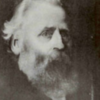More about The True American

Sr. Contributor
Enoch Wood Perry painted many portraits and landscapes but was best known for his genre paintings; in his case, these were scenes of daily life in rural 19th century America. Some of his works along these lines include Talking It Over (where he puts the faces of Abraham Lincoln and George Washington on two farmers), The Pemigewasset Coach, A Month's Darning, The Clock Doctor, and our subject here: The True American.
As genre paintings go, The True American is kind of a weird one; it doesn’t really fit neatly into any of the usual boxes. In European genre paintings, there are often a lot of tavern scenes, which could make for some really interesting details within the painting, like Peasants Making Merry outside a Tavern 'The Swan' by Pieter Brueghel the Younger. American genre paintings, in comparison, were mostly pretty tame; there were plenty of folksy farmers, hayrides, children playing, country fairs, Cider Making, and so on.
Some of these paintings had some subtle or not so subtle double meanings relating to politics, current affairs, or social ills, while others were just what they appeared to be: a slice of life on any given day in America. The True American (also titled The Bummers), however, doesn’t look like a typical rural scene. For one thing, the subjects are on the porch of a hotel, for another, every figure’s face is hidden. Even the dog and the horse have been rendered headless! These guys on the porch aren’t even trying to be clever about it, they’re just flat-out hiding like the paparazzi are coming up the walk.
The subject matter of this work may be considered satirical - a possible commentary on the ignorance of voters in the United States during the era of Reconstruction. Since the men in the picture don’t have heads, they can’t have brains - simple, right? That is one theory; another says that “the ‘true’ American, defined by his or her own local values, traditions, and experiences, has been standardized by the mass media.”
There were a few real newspapers with the name of The True American; one of them was published by the Know-Nothing party during the 1850s. This might be a better fit as far as making sense of this one. Basically, the beliefs of the party were anti-Catholic, anti-Irish (because Catholic), and generally xenophobic. Another newspaper with that name and matching masthead was an abolitionist paper published in Kentucky in the 1840s, so the mystery continues…
As for the the attribution of this painting to Perry, the only signature to be found is a little monogram on the lower left that looks like it contains the letters, E, W, and P, if you look closely. This monogram/signature does not appear in any other known works by Perry, so just another question without an answer. There was also a print of this piece published in 1875, available by subscription; this print contained zero references to Perry, or any other artist for that matter. So, to be clear as mud, we really don’t know what the hell is going on here, either with the meaning, and maybe even the artist, but that’s ok; you don’t always have to have a logical explanation to enjoy a piece of art.
Sources
- “American Scenes of Everyday Life, 1840–1910.” Metmuseum.org. https://www.metmuseum.org/toah/hd/scen/hd_scen.htm.
- Applebaum, Lauren. “Elusive Matter, Material Bodies: American Art in the Age of Electronic Mediation, 1865-1918,” 2019.
- “Enoch Wood Perry Jr.” Wikipedia. Wikimedia Foundation, May 14, 2022. https://en.wikipedia.org/wiki/Enoch_Wood_Perry_Jr.
- Hesselman, Dorothy. “‘Talking It over’: A Patriotic Genre Painting by Enoch Wood Perry.” Metropolitan Museum Journal 33 (1998): 297–303. https://doi.org/10.2307/1513020.
- Spassky, Natalie, Linda Bantel, and Kathleen Luhrs. American Paintings in the Metropolitan Museum of Art. 2. Vol. 2. New York: The Metropolitan Museum of Art, 1985.
- “The True American.” Metmuseum.org.https://www.metmuseum.org/art/collection/search/11759.
- Weinberg, H. Barbara, and Carrie Rebora Barratt. American Stories: Paintings of Everyday Life, 1765-1915. New York, N.Y: Metropolitan Museum of Art, 2009.











